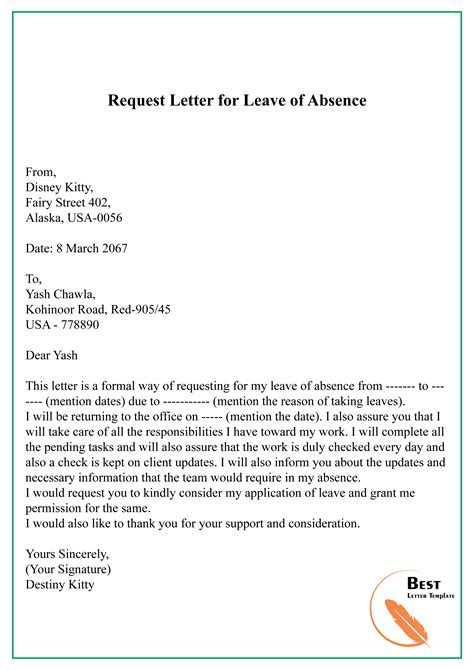Example Of Formal Leave Of Absence Letter Request

When you need to take a leave of absence from work or school, it’s important to do so in a formal and professional manner. Writing a leave of absence letter is the best way to communicate your need for time off and ensure that your request is taken seriously. In this post, we’ll provide an example of a formal leave of absence letter request and walk you through the key elements to include.
Heading 1: Introduction
Start your letter by addressing it to the appropriate person or department. This could be your supervisor, manager, HR department, or school principal, depending on your situation. Make sure to include the date and a clear subject line that indicates the purpose of your letter.
Heading 1.1: Salutation
Use a formal salutation, such as “Dear Mr./Ms./Dr./Prof. [Last Name],” followed by a colon. If you don’t know the recipient’s name, use a generic greeting like “To Whom It May Concern.”
Heading 1.2: Subject Line
Your subject line should be brief and to the point. It should clearly state the reason for your letter, such as “Request for Medical Leave of Absence” or “Request for Personal Leave of Absence.”
Heading 2: Body Paragraphs
The body of your letter should explain the reason for your leave of absence and provide any necessary details or documentation. Be honest and straightforward in your communication, and avoid oversharing personal information that is not relevant to your request.
Heading 2.1: Reason for Leave
Start by explaining the reason for your leave of absence. This could be due to a medical condition, a family emergency, personal reasons, or any other valid reason that requires time off from work or school. Be clear and concise in your explanation, and provide any necessary details or documentation.
Heading 2.2: Duration of Leave
Specify the dates of your leave of absence and how long you expect to be away. If you’re not sure how long you’ll need to be away, provide an estimate and indicate that you will provide updates as necessary.
Heading 2.3: Request for Approval
Clearly state that you are requesting approval for your leave of absence and that you understand any policies or procedures that may apply. Be respectful and professional in your tone, and express your willingness to work with your supervisor or HR department to ensure a smooth transition before and after your leave.
Heading 3: Closing Paragraph
End your letter by thanking the recipient for their time and consideration. Provide your contact information and any other relevant details, such as how you can be reached during your leave of absence. Sign your letter using a formal closing, such as “Sincerely” or “Best regards,” followed by your full name.
Heading 4: FAQs
Here are some frequently asked questions about writing a formal leave of absence letter:
Heading 4.1: What should I include in my leave of absence letter?
Your leave of absence letter should include your reason for taking time off, the dates of your absence, and a request for approval. You may also need to provide documentation, such as a doctor’s note or a family emergency leave policy.
Heading 4.2: Who should I address my leave of absence letter to?
You should address your letter to the appropriate person or department, depending on your situation. This could be your supervisor, manager, HR department, or school principal.
Heading 4.3: How long should my leave of absence letter be?
Your letter should be brief and to the point, typically no more than one page in length. Be clear and concise in your communication, and avoid oversharing personal information that is not relevant to your request.
Heading 4.4: When should I submit my leave of absence letter?
You should submit your letter as soon as possible, ideally at least two weeks before your intended leave of absence. This allows your employer or school to make arrangements for your absence and ensures that you have enough time to provide any necessary documentation.
Heading 4.5: What if my request for leave of absence is denied?
If your request for leave of absence is denied, you may need to explore other options, such as taking unpaid time off, using vacation or sick days, or seeking legal advice. It’s important to understand your employer or school’s policies and procedures, as well as any applicable laws or regulations.
“A formal leave of absence letter is the best way to communicate your need for time off and ensure that your request is taken seriously.”
In conclusion, writing a formal leave of absence letter is an important step in taking time off from work or school. By following the key elements outlined in this post, you can ensure that your request is professional, respectful, and effective. Remember to be clear and concise in your communication, provide any necessary details or documentation, and express your willingness to work with your employer or school to ensure a smooth transition before and after your leave.
